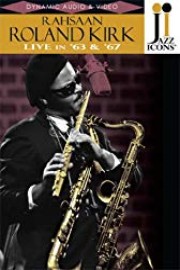-
Genres
-
CastRahsaan Roland Kirk
-
DirectorDavid Peck
-
Release Date2008
-
MPAA RatingNR
-
Runtime1 hr 19 min

Kirk, Roland: Live in '63 and '67 is a must-see film for any jazz enthusiast. The movie features two historic performances from multi-instrumentalist Rahsaan Roland Kirk, showcasing his virtuosic skills as a saxophonist, flutist, and clarinetist. The first performance, recorded in Belgium in 1963, captures Kirk at the height of his powers. Backed by a solid rhythm section, the saxophonist launches into a blistering rendition of "One Ton" that sets the tone for the rest of the set. Kirk's improvisational prowess is on full display as he jumps from one instrument to the next, incorporating elements of blues, bebop, and avant-garde jazz into his playing.
One of the highlights of the set is Kirk's rendition of "Moon Song," a haunting ballad that showcases his lyrical side. The saxophonist's warm tone and delicate phrasing are a reminder that, despite his reputation as an experimentalist, Kirk was also a deeply emotional player.
The second performance, recorded in Norway in 1967, finds Kirk in a more playful mood. Backed by a young and energetic band, Kirk delivers a scorching version of "Serenade to a Cuckoo" that features some of his trademark extended techniques, including circular breathing and playing multiple horns at once.
The setlist also includes some of Kirk's original compositions, such as "The Inflated Tear" and "Rahsaan's Spirit," which give the saxophonist plenty of room to showcase his adventurous spirit. Kirk's bandmates, including pianist Ron Burton and drummer Joe Habao Texidor, keep up with him every step of the way, adding their own unique flavors to the mix.
Throughout both performances, Kirk's physical presence is a sight to behold. The saxophonist, who was partially blind, often played with two or even three horns at once, using his body as a kind of percussion instrument. His onstage antics, which included wearing multiple hats and playing saxophone with his nose, were as much a part of the show as his music.
The film itself is a testament to Kirk's enduring legacy. Shot in black and white, the footage has a timeless quality that makes it feel as alive and immediate as when it was first recorded. The close-up shots of Kirk's fingers dancing across the keys of his instruments are particularly mesmerizing, giving viewers a window into the saxophonist's creative process.
In between the performances, there are interviews with Kirk and other musicians, including Dizzy Gillespie and Quincy Jones, who offer insights into Kirk's musical genius. These moments are a welcome respite from the intensity of the live performances, giving viewers a chance to catch their breath and reflect on what they've just witnessed.
In the end, Kirk, Roland: Live in '63 and '67 is a testament to the power of jazz as a live art form. The film captures a moment in time when one of the greatest saxophonists of all time was at the peak of his creative powers, pushing the boundaries of what was possible on his instruments. It's a film that any fan of jazz, or music in general, should seek out and experience for themselves.